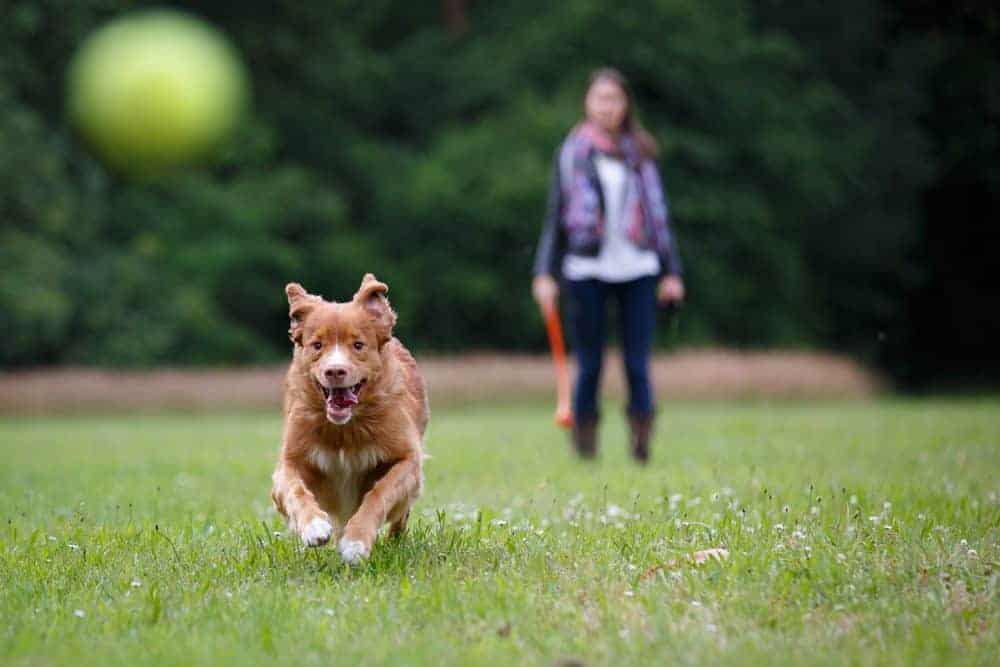
Dog? Check. Lead? Check. Poop bags? Check. Treats? Check. Ball. Check. Ball flinger? Check. Long-range ball flingers have become a regular part of many a dog owner’s walkies kit. After all, they make launching a ball off into the distance easy for just about anyone, providing your canine chum with plenty of exercise as they swiftly give chase. But could they be doing more harm than good?
Vet Hannah Capon, who founded the Canine Arthritis Management website, believes that continually running after a ball thrown long distance by a flinger can put unnecessary strain on a dog’s joints, muscles and cartilage, resulting in long-term health problems such as arthritis.
Dogs running like athletes
Commenting in the Daily Express she says: “We need to realise we’re asking dogs to run like athletes. They’re going from standing still to a gallop, then throwing themselves in the air, braking and skidding. This might be up and down a hill or on a beach, and it’s causing damage to their joints and trauma to muscles and cartilage. But, because the dog is so excited, they carry on through the pain.”
Dr Capon even goes as far as suggesting that it can affect a dog’s life expectancy: “For the many dogs who might have injuries or mobility problems, we’re making these even worse, meaning pets need to be on medication. This can take years off their life expectancy.”
But running after and fetching a ball is a favourite game for many canines, which owners will be reluctant to give up. What’s Dr Capon’s advice? She says: “We all want our dogs to live as long as possible and not to be in pain. A few simple changes to the way we play with them can give you and your dog more years together.”
Dr Capon’s advice for safer ball games
- Owners should make sure their dog is healthy first of all and has no injuries or mobility problems
- Dogs should also be warmed up before playing with a ball so muscles are prepared
- Dogs shouldn’t play with a ball on a slippery surface, up and down hills or run for hours on a beach
- Throw the ball by hand, rolling it on the floor rather than up high, making the dog jump up
- Put a time limit on ball chasing. no matter how much pain the dog is in, the power of the ball is stronger and they will keep running after it.
Arthritis in dogs
Canine Arthritis Management explains it like this:
Arthritis (osteoarthritis – OA) is the most common cause of chronic pain in dogs. It affects four out of five older dogs. It’s a disabling, non-curable, and progressive disease which initially focuses on moving joints but eventually affects the whole dog and is a major cause of euthanasia due to loss of quality of life. It’s an extremely complex disease that requires a dedicated owner collaborating well with their vet to control the pain, maximise the mobility and ensure a full and active life for their dog.
In basic terms, the progression of osteoarthritis can be summarised like this:
- Degeneration of the normal structures within a joint
- Pain causes reduced use of the joint and the limb
- Surrounding muscles, ligaments and tendons become weak
- The body compensates elsewhere which causes more pain
- The brain becomes more aware of the constant pain and magnifies it
Could your dog have arthritis?
Have you noticed that your dog’s energy levels are decreased, their enthusiasm to exercise is reduced, or their normal habits of stretching, shaking and rolling have become infrequent, replaced with something new such as licking their front paws? Or maybe they just seem to want to be left alone more of the time. Contact your vet as they may have arthritis.
- For lots of useful information about managing arthritis and keeping your pets pain free, visit caninearthritis.co.uk
If you found this interesting, you may also like:
IS TOO MUCH BALL THROWING STRESSING OUT YOUR DOG?
A game of fetch with a favourite ball is a much-enjoyed pastime for many canines and can be a great way to ensure they are getting plenty of exercise. But, could too much ball chasing and catching be a bad thing?
SCRATCH AND SNIFF
When you take your dog out for a walk, do you allow them time to follow their nose and enjoy lots of sniffing activity? Find out why having a good sniff is super important to your canine pal – and how it can even help address behaviour issues and improve recall...
IS TAKING YOUR DOG FOR A WALK A TUG OF WAR?
Pulling on the lead is a behaviour that many dog owners grapple with on a daily basis. But with training, patience and plenty of encouragement, every dog can learn to walk nicely on the lead.
Sources: express.co.uk, caninearthritis.co.uk














